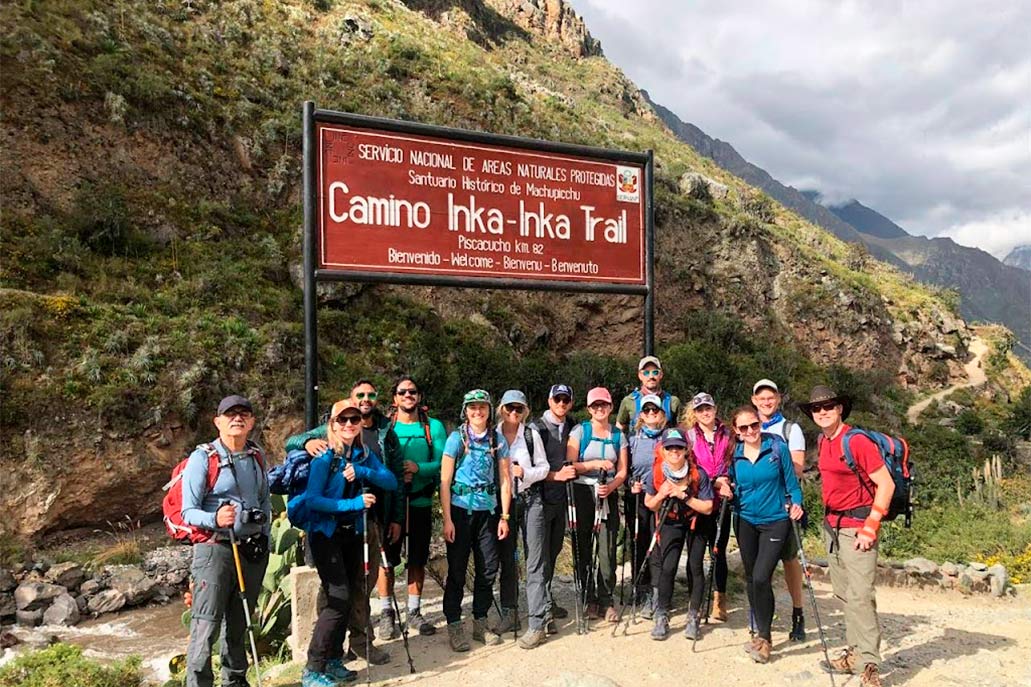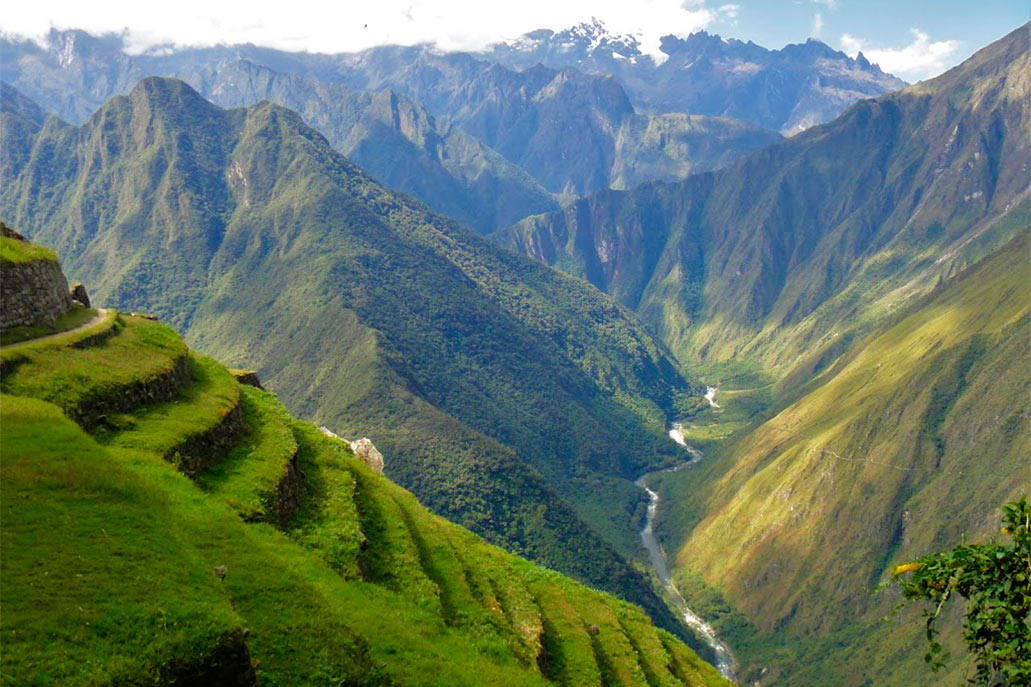The Inca Trail to Machu Picchu
The Inca Trail to Machu Picchu is the most famous trekking route in Peru and one of the best in the world. Unlike other trekking routes through Cusco, it crosses trails built by the Incas. These roads lead to nothing less than the Inca city of Machupicchu. The only way to do this walk is to buy an all-inclusive tour online. Due to the high demand of tourists requesting this tour, the purchase must be made 6 or 7 months in advance.

Content
The best hiking trail on the planet
The Inca Trail is considered one of the best hiking trails on the planet. The reason? Travel through historic roads built by the Incas themselves until arriving at nothing less than Machu Picchu, one of the best destinations in the world.
The walk is 39 kilometers (in 4 days). It starts at kilometer 82 of the railway that goes to Machu Picchu. The route ends at the Intipunku, the gateway to the citadel in Inca times. The roads that it travels are part of the qhapac ñan or Inca road network that stretched for thousands of kilometers. The section of the Inca Trail was the route that linked the city of Cusco with Machupicchu.
The route is full of incredible landscapes. In the first two days you climb high Andean mountains. The last two days descend through landscapes of the Cusco jungle. On the morning of the fourth day you arrive at Machu Picchu. This first view of the Inca citadel is different from other tourists. They do it through the general door located at the bottom of the citadel. Visitors who arrive by the Inca Trail appreciate Machupicchu with a panoramic view, from the top of the citadel. For many, this first impression is unforgettable.
Route protected by the Peruvian State
Because the Inca Trail to Machu Picchu covers 39 kilometers of routes from qhapac ñan, its trails are protected by the Peruvian State. This means that no person without special permission can travel the route. Permits are only acquired by purchasing the Inca Trail tour with an authorized tourism agency.
Another reason to protect the route of the Inca Trail is that through its trails Inca archaeological sites such as Llactapata, Runkurakay, Sayacmarca, Phuyupatamarca, Wiñayhuayna and, of course, Machu Picchu are crossed. These Inca citadels can only be visited by people who make the trekking route.
Likewise, along the Inca Trail there is a great diversity of flora and fauna. Among the plant species, mosses, bushes, ferns and, above all, orchids (known as the Machu Picchu flower) stand out. The most representative animal species are: the spectacled bear, the Andean deer, the llama, the vizcacha and the different birds (especially the cock of the rocks, the national bird of Peru).
The price and purchase of the Inca Trail tour

The tour to the Inca Trail includes everything you need for the trek: permits for entry, cooks (3 breakfasts, 3 lunches and 3 dinners), porters (equipment of necessary utensil loaders), professional tour guide, equipment of camp (tents, tables and other utensils), entrance to Machu Picchu and return to Cusco by train.
Tours are priced at approximately $ 700. There are discounts for university students. The purchase of the tour is done with an authorized tourism agency. Due to the high demand for tours, the only way to purchase one is online 6 or 7 months in advance. Otherwise, you will not find availability.
The first day of hiking
The first day of the tour begins in the city of Cusco and ends at the Huayllabamba camp. During the walk, and throughout the entire route, visitors will be accompanied by a professional tour guide as well as the team of cooks and porters.
The route begins with the trip in tourist transport from the city of Cusco to kilometer 82 of the railroad to Machu Picchu.
Once at the starting point, the tourists will begin the ascent on foot, which that day will be approximately 13 kilometers. Halfway through, there will be a stop for lunch at the Tarayoc camp.
At the Huayllabamba camp, tourists will dine and camp.
The second day of hiking
The second day of the tour begins at the Huayllabamba camp and ends at the Pacaymayo camp. On that day, visitors will walk approximately 11 kilometers. For many it is the most difficult day as it travels through high-altitude Andean mountains.
The route begins with a very early breakfast at the Huayllabamba camp. Then you walk uphill until you reach the highest point of the route: the Warmihuañusca pass (at 4,200 meters above sea level).
Halfway there will be a stop for lunch at the Pacaymayo camp.
That same afternoon, tourists can walk to the archaeological site of Runkuracay. At night they will have dinner and spend the night in the Pacaymayo camp.
The third day of hiking

The third day of the tour begins at the Pacaymayo camp and ends at the Wiñayhuayna camp. That day the tourists will travel approximately 16 kilometers. Because this distance is downhill through landscapes of the Cusco jungle, the route is comfortable.
The route begins with a delicious breakfast at the Pacaymayo camp. Next we visit the archaeological site of Sayacmarca.
In the afternoon, visitors will rest at the Chaquicocha camp where they will have lunch. Then the route continues to visit the Inca site of Phuyupatamarca.
The route ends at the Wiñayhuayna camp where tourists will dine and camp near the archaeological site of the same name.
The fourth day of hiking
The fourth and final day of the route begins with a nutritious breakfast. Then the tourists say goodbye to the team of porters and cooks since there is only a few kilometers left to get to Machu Picchu.
Very early, visitors will arrive at Machu Picchu through the Intipunku. After taking the respective photos, the tour of the archaeological site begins, always in the company of the tour guide.
In the afternoon we descend to the town of Aguas Calientes for lunch (not included in the tour). Finally, at the agreed time, tourists must board the train that will take them back to the city of Cusco. There the Inca Trail ends.
More information on the hike
The Inca roads were the Inca road network that covered more than 30 thousand kilometers through the Andean and coastal territories of present-day Peru, Bolivia, Ecuador, Colombia, Chile and Argentina.
The Classic Inca Trail lasts 4 days and covers 39 kilometers. There is also a short alternative route that takes only 2 days and covers approximately 11 kilometers. This crosses the last section of the classic route. The short tour, unlike the 4-day route, can be purchased just weeks in advance.
In addition to the natural wear and tear due to the 39 kilometers of walking, during the Inca Trail tourists also experience fatigue due to the high altitude (they can suffer from altitude sickness or soroche). For this reason, it is recommended to drink plenty of water and avoid alcoholic beverages or fatty foods before starting the route.
The Inca Trail tour can be purchased by all people. However, it is recommended that the little ones are over 8 years old and like routes of this type. Older adults must be in good physical condition. They should preferably consult with their doctor.